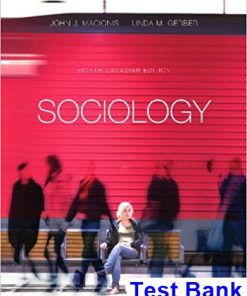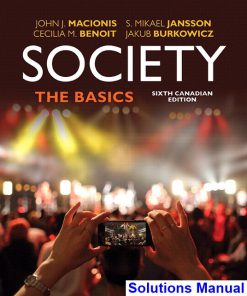Society The Basics Canadian 6th Edition Macionis Test Bank
You may also like
Society The Basics Canadian 6th Edition Macionis Test Bank

Product details:
- ISBN-10 : 0130410489
- ISBN-13 : 978-0130410481
- Author: John J Macionis (Author), Cecilia M. Benoit (Author), S. Mikael Jansson (Author
Society: The Basics, Sixth Edition, offers a complete multimedia learning program in sociology including a carefully coordinated package that includes the book, a free interactive CD-ROM in every copy, and an innovative Companion Website™. The book features a balanced theoretical foundation: structural-functional, symbolic-interaction, and social-conflict analysis is supplemented by cultural ecology, social exchange theory, and sociobiology. In addition, the three main themes that make up the core of the book remain: Social Diversity within the United States; a Global Perspective; and an emphasis on Critical Thinking. Barcoded websites in each chapter allow readers to use CueCat scanning—provided free—to take readers into the world of learning available on the Internet. New Sites to See sections introduce students to a wide range of organizations involved in relevant research or social action. An excellent resource for professionals in the field of sociology.
Table contents:
Chapter 1 Sociology: Perspective, Theory, and Method: A new chapter opening contrasts the rich and poor in Boston, Massachusetts; there are updates of suicide patterns in the United States; the discussion of social change and the emergence of sociology has been reorganized; find an update on women in professional sports as well as a new Diversity Snapshot figure on race and football; the sociological methodology section has been heavily revised to contrast three approaches: scientific sociology, interpretive sociology, and critical sociology; the chapter ends with an updated and expanded list of Applications and Exercises as well as new Sites to See.
Chapter 2 Culture: A new chapter opening traces the rise of hip-hop culture; two new national maps showing beer and wine consumption illustrate high and popular culture; many updated examples and illustrations are found throughout the chapter; the chapter ends with an expanded list of Applications and Exercises as well as new Sites to See.
Chapter 3 Socialization: This chapter includes an update on U.S. television watching, a new national map on newspaper readership, and recent research on television and violence; a new figure highlights young people’s trust in parents; expanded and updated Applications and Exercises are included as well as numerous new Sites to See.
Chapter 4 Social Interaction in Everyday Life: This chapter now has more emphasis on applications throughout; an expanded Applications and Exercises section includes new on-campus activities; there are also several new Web destinations in the Sites to See.
Chapter 5 Groups and Organizations: A major reorganization of this chapter adds discussion of early scientific management and traces the evolution of organization toward a flatter, flexible, “intelligent” form; the chapter also contrasts the rise of intelligent organizations doing highly skilled postindustrial work with the countertrend toward low-skill service work, often called “McJobs.”
Chapter 6 Deviance: A new chapter opening points out weaknesses in the criminal justice system; there are new sections on corporate crime and organized crime; all crime statistics are updated; a new Critical Thinking box explains the recent decline in violent crime; the chapter ends with new Applications and Exercises as well as new Sites to See.
Chapter 7 Sexuality: This new chapter highlights the socially constructed character of human sexuality; the chapter takes a global view of sexuality, and also surveys a number of sexuality issues, from sexual orientation to sexual violence; there are several new boxes, a new national map on births to teenage women, and new Applications and Exercises as well as new Sites to See.
Chapter 8 Social Stratification: This chapter has a reorganized discussion of caste and class; recent changes in the British aristocracy are noted; find updates on income and wealth disparity in the United States; there are new data tracking rising African American affluence; new Applications and Exercises and new Sites to See conclude the chapter.
Chapter 9 Global Stratification: A new opening profiles wage slavery in the sweatshops of a Pacific territory controlled by the United States; a dramatic new Global Sociology box describes the culture of slavery in North Africa; the chapter includes updates on global wealth and well-being; several new Sites to See direct students to sources of global data and further study.
Chapter 10 Gender Stratification: A new chapter opening highlights the 1848 Seneca Falls convention and the women’s movement it began; the chapter includes statistical updates on women’s pay, schooling, and jobs; a new Diversity Snapshot figure details who does the housework in the United States; many of the Applications and Exercises as well as Sites to See are new.
Chapter 11 Race and Ethnicity: A new Social Diversity box highlights the role played by immigrants in the U.S. economy; the chapter adds a set of four national maps showing the diminishing lands controlled by American Indians; updated statistics reflect the social standings of all racial and ethnic categories in the United States; several new Applications and Exercises as well as new Sites to See end the chapter.
Chapter 12 Economics and Politics: There is a new chapter opening on the trend toward using temporary workers; find updated statistics on the U.S. labor forceincluding unemployment rates and the gender, racial, and ethnic composition of the labor force; a new Controversy & Debate box highlights corporate welfare; we’ve added another national map showing where jobs will be a decade from now; the chapter includes an update on political freedoms around the world; a new national map shows the popular vote by county in the 2000 presidential election; there is an update on nuclear proliferation worldwide; several new Applications and Exercises as well as Sites to See complete the chapter.
Chapter 13 Family and Religion: A new chapter opening presents the “family values” debate in terms of a new Vermont law establishing civil unions for same-sex couples; a research update reports on the causes and consequences of cohabiting; a new Critical Thinking box evaluates the covenant marriage law in Louisiana; the chapter notes the rising number of Muslims in the United States; a new Controversy & Debate box looks at the resurgence of prayer in school; find many statistical updates on various measures of religiosity; a new national map shows membership in religious organizations across the United States; there are statistical updates on all the trends regarding family and religious life, as well as new Exercises and Applications and Sites to See.
Chapter 14 Education and Medicine: A new chapter opening looks at a controversial school-funding law in Vermont; a new national map shows life expectancy for women and men across the country; a new Global Sociology box describes the free-fall in life expectancy among men following the collapse of the former Soviet Union; statistical updates are included for all measures of educational achievement and health, and the chapter ends with a number of worthwhile Web sites on these important issues.
Chapter 15 Population, Urbanization, and Environment: This chapter is a new combination of population, urbanization, and environment; a new chapter opening reports on the rapid urban development in Atlanta; find the latest global population figures as well as new demographic data for the United States; there is an update on the development of urban regions and sprawl; throughout the chapter the focus is on the interplay of population, urbanization, and the physical environment; many new Applications and Exercises as well as Sites to See complete the chapter.
Chapter 16 Social Change: Modern and Postmodern Societies: A new chapter-opening vignette illustrates the extent of social change over the course of the twentieth century; expanded coverage of the theories of social movements includes a new discussion of culture theory; a new Critical Thinking box evaluates the changing quality of life in the United States; there are many Applications and Exercises as well as new Sites to See.
People also search:
society the basics 6th canadian edition
basic things to know about canada
basic information about canada
canadian government structure for dummies
6 facts about canada












